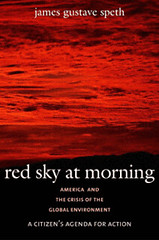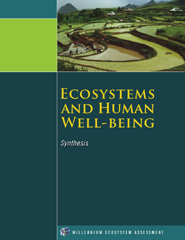Eco: Has the canary keeled over?
Coal miners once took canaries into the mines to serve as sentinels and warn them about underground hazards such as poisonous gas. If a bird wobbled on its perch miners knew it was time to get out. Today, a group of scientists led by a Yale physician is working to understand how other animals may be used to warn us about current risks to human health, including many associated with patterns of environmental change over the past fifty years.
“It’s clear that animals can be useful as sentinels,” says Dr. Peter Rabinowitz of the Yale Occupational and Environmental Medicine Program, “the question is how to interpret what we see.” Dr. Rabinowitz is the primary investigator assembling an online research library called “The Canary Database.” The database organizes scientific studies about the health of wild animals, domestic animals and pets in an effort to learn whether effects that chemical, biological and physical hazards in the environment have on animals also warn about human health risks. It is a cooperative effort between Yale Occupational and Environmental Medicine, Dr. Joshua Dein of the USGS National Wildlife Health Center, The Yale Center for Medical Informatics, and the Consortium for Conservation Medicine.

Dr. Rabinowitz (above) says it was through his practice of environmental medicine, where he investigated how patients’ living or working environments made them sick, that he became interested in animal health trends. “Seven or eight years ago, there was a lot of concern that animals were becoming sick from persistent chemicals in the environment,” Dr. Rabinowitz recalls. “Animals were having birth defects related to man-made chemicals. A related issue was frog deformities. These were seen as a sort of warning call to human health professionals. Are these problems related to something in the water or in the air? What’s causing them? Should we worry?
“Years later, we’re still not sure why animals have these problems, what’s causing them, or if human health care professionals should worry. Right now, we don’t routinely do things differently if a patient lives near a pond with deformed frogs. It doesn’t come into our medical decisions.”
The idea for the Canary Database grew from the group’s curiosity about what evidence was being collected about trends in animal health, its desire to look for any possible links to human health, and interest in determining what conclusions the facts would support. It seemed like a reasonable approach. “We use animal studies for lots of things in medicine,” Dr. Rabinowitz explains. “I was interested to see if we could get information about animals such as frogs in their environments—and figure out if there was a message for human health.”
A Sea Change
More recently, the spread of infectious diseases and the risks they pose—such as the potential for the outbreak of a deadly pandemic—have given new urgency to questions such as several the Canary Database team has set out to explore. Viruses such as H5N1, the so-called “bird flu,” with its potentially devastating implications for human populations, have increased interest in monitoring and analyzing trends in animal health.
“The emergence of these diseases has brought about a sea change,” notes Dr. Rabinowitz. “It took a while for people to realize that when birds are dying around us we should worry about things like West Nile Virus. Since West Nile, other things with similar messages have hit us. One was Monkey Pox. Another was SARS, an animal disease that broke out in the human population. Was the outbreak related to environmental change in China? Was it something we hadn’t detected before? We don’t know.
“Physicians are not trained much in thinking about sick animals. That is a challenge outside the medical model of ‘what’s the diagnosis and which medication is indicated?’ The care model we’re investigating would have us looking more broadly at patients’ environments. We thought we’d put together a scientific database to look for connections [between animal and human health], evaluate how good the connections are and provide a resource for animal health and human health professionals.
Combing Through The Evidence
As ambitious as his aspirations may be, Dr. Rabinowitz appears firmly grounded. The first challenge for the Canary Database is to make muster scientifically, and he is both serene and accepting when it comes to the implications for what could be his life’s work. “We’re trying to get a foothold on huge questions,” Dr, Rabinowitz says, retaining his focus on a few, specific human health issues the group has identified as places to start. “Medicine is evidence-based. We say ‘show us the data. Show us that this is really something to worry about—because we have lots of things to worry about.’”
The group has identified areas to investigate, where animal health data may provide warnings that have specific applicability for human health professionals. A primary focus is to understand how information about animal health might be used to respond to and manage human health risks associated with emerging infectious diseases.
“We’re starting to take for granted that animals can be an important link in tracking emerging infectious diseases (EIDs),” says Dr. Rabinowitz, “but in 1999 it was a big deal to think that dead crows in the Bronx should mean anything to human health. At that point, it was not an easy sell.” Since West Nile, more and more physicians have come to recognize the eerie similarities between a canary falling off its perch in a coal mine and crows dropping off phone poles.
Besides EIDs, the group is investigating whether animals might also provide early warnings about terrorist attacks involving biological or chemical agents. For example, one study in the database found that an inadvertent release of the biological agent anthrax in the Soviet Union in 1979 was more lethal, over a greater range, for livestock than humans. Another area of inquiry has to do with the effects of endocrine disrupting chemicals that today pollute many natural environments. The chemicals have been associated with reproductive system abnormalities and failure in animals and environments such as alligators in Florida swamplands, but little is known about what these occurrences may foretell about human health.
Finally, the group is also looking into how the health of household pets’ may warn about hazards in domestic environments, such as lead poisoning caused by exposure to lead paint or cancer risks linked to household pesticide use. As is often the case with environmental medicine, the questions are complex, and the group is methodical in its search for answers. “We can make two mistakes,” Dr. Rabinowitz explains. “One is that we ignore animal signs that we should be worrying about. The other is that we get too excited about things that may be natural occurrences, and not actual hazards to human health. We’re trying to show what the evidence is, so we can determine the right approach.”
Health & Global Environmental Change
In the search for links between trends in animal health and warning calls for human health the elephant in the room is global environmental change. Have man-made (anthropogenic) changes over the past half century, such as pollution, deforestation and wildlife habitat degradation, led to increases in environmental risks to human health? Are we contributing to the emergence of infectious diseases? Do animal health issues such as birth defects and reproductive failure foretell of human health problems to follow?
Today, it is practically impossible to know what the effects of human impacts on the environment will be for human health, but where our impacts were once local, they have grown to the point where patterns of anthropogenic environmental change are recognizable around the globe. Impacts humans are having on animal populations are apparent practically everywhere.
In his book, Red Sky At Morning, (Yale University Press, 2004) James Gustave Speth details the progress of human activities, human impacts and environmental change during the 20th century, especially since the 1950s. A co-founder of the Natural Resources Defense Council and an environmental policy advisor to President Jimmy Carter, Speth catalogs a broad spectrum of environmental changes that have occurred and links them with possible effects.

Speth draws connections between anthropogenic environmental change and declines in biodiversity, as tracked by species’ extinction rates, which are off the charts compared to any other period in the 3.5 billion-year history of life on earth. He writes that the extinction rates today are “100 to 1,000 times the normal rate.” Even a mass extinction that occurred at the end of the Permian Period of some 250 million years ago, a time when up to 90% of all living families on land and in the seas disappeared, and until now the greatest mass extinction known, may pale by comparison with the declines in biodiversity occurring around the globe today.
Speth argues that the issue goes deeper than species loss, to the point where global ecosystems are being pushed to the brink. He writes that patterns of ecosystem change pose “far greater practical consequences for human livelihoods and U.S. interests,” and that within our lifetimes we are witnessing sharp declines in “the ability of these systems to meet human needs...Many now believe that the strong back on which to put the case for conserving biodiversity is ecosystem services, by which they mean the valuable goods and services that human societies derive from natural systems,” Speth writes. “The best way to save biodiversity, they contend, is to convince people that healthy ecosystems provide societies with a huge array of benefits.”
The World Health Organization (WHO) is also warning of the consequences of ecosystem degradation in a report released last week, "Ecosystems and Human Well-Being: Health Synthesis."

The report warns that the consequences to human health are already being felt—and could grow significantly worse. "Human health is linked to the health of ecosystems," said Maria Neira, Director of WHO's Department for the Protection of the Human Environment. "We in the health sector need to take heed of this...together with other sectors."
Sentinels for global environmental change?
When asked whether the Canary Database might one day identify specific connections between ecosystem health, biodiversity and human health, things policy advocates such as Speth might use to develop the kind of broad-based political support that will be required to begin to remediate man’s impact on the environment, Dr. Rabinowitz remains stoic.
“In environmental medicine we make links between environmental factors, like drinking water, and human health. Our premise is that it’s sometimes harder to get a clear picture if you look at humans and ignore other organisms in the environment. Animals do not move around as much [as humans]. They may be more susceptible. They may have shorter life spans, so you may see things in animal populations that may take longer to appear in human populations.
“But you don’t want to overreach and say there are connections if there aren’t. We want to be able to find the most important things, like avian influenza, and get people to focus on them.” Dr. Rabinowitz says the group has a long way to go before it can offer evidence or draw any connections between global environmental change, declines in biodiversity, and human health effects.
“There is some concern,” Dr. Rabinowitz explains, “that as biodiversity declines you have greater chance for outbreaks of infectious diseases in wild populations. Infectious disease ecologists are really interested in these types of questions, but right now this kind of work often falls between the cracks of defined medical or scientific fields.”
Opening lines of communication
Trying to close those cracks is yet another challenge the group hopes to tackle once it makes progress on building a case for the use of animals as sentinels. “We’re trying to pick up on the effects of things like biodiversity and deforestation,” says Dr. Rabinowitz. “Very little linkage work has been done yet on that, but as it goes on, animals are usually in there somewhere.” As things are now, infectious disease research is typically done in medical school laboratories by researchers looking at a specific bug, or pathogens. “They may have an ecologist somewhere who is an expert on biodiversity,” Dr. Rabinowitz explains, “but we find that bringing together physicians and veterinarians and ecologists is always a bit of a job.
“We are seeing epidemiology [the study of factors that lead to the occurrence and spread of disease] as a common language that can help bridge [scientific and medical] disciplines working on different aspects of ecosystem health, animal health, and human health. It’s one way we can open up channels of communication so that we can get a clear signal of what’s important and what’s not. There’s been a change in the past five years, communication has started, and is ongoing. There is a lot of good cross-discipline work that is now starting to happen.
“Have diseases broken out of animal populations in the past and caused widespread disease in human? Yes. Is there more of that happening now at a faster pace? It’s certainly possible. We’re still figuring it out. We’re saying that animal health epidemiologists and human health epidemiologists and ecologists should be using epidemiology as a common way to identify the most important factors, how we can pick them up, and decide what to do about them,” Dr. Rabinowitz explains. “I think we have something to learn from animal health professionals and ecologists.” And perhaps, most of all, from animals such as the canary.